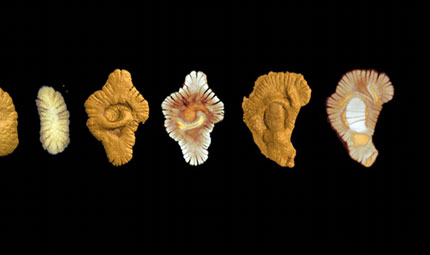That means organized life is a lot older than was scientifically accepted, though older existence was obviously assumed because the first traces of life appeared in the form of prokaryotic organisms (without a nucleus) 3.5 billion years ago. The "Cambrian explosion" 600 million years ago marked a proliferation in the number of living species and was accompanied by a sudden rise in oxygen concentration in the atmosphere.
What happened between 3.5 billion and 600 million years ago? Scientists have little information about the Proterozoic era and more understanding will be key because it is during this crucial period that life diversified; to the prokaryotes were added the eukaryotes - single or multicelled organisms endowed with a more complex organization and metabolism. These large-sized living beings differ from prokaryotes by the presence of cells possessing a nucleus containing DNA.

Discovery of a complex, multicellular life from over two billion years ago. Credit: CNRS Images
While studying the paleo-environment of a fossil-bearing site situated near Franceville in Gabon in 2008, Abderrazak El Albani of the Laboratoire "Hydrogéologie, Argiles, Sols et Altérations" (CNRS/Université de Poitiers) and his team unexpectedly discovered perfectly preserved fossil remains in the 2.1 billion-year-old sediments. Since then, they have collected more than 250 fossils, 100 have been studied in detail and their morphology cannot be explained by purely chemical or physical mechanisms.
These specimens, which have various shapes and can reach 10 to 12 centimeters, are too big and too complex to be single-celled prokaryotes or eukaryotes, which establishes that different life forms co-existed at the start of the Proterozoic, as the specimens are fossilized living material. To demonstrate this, the researchers employed techniques that allowed them to define the nature of the samples and to reconstruct their environment: An ion probe capable of measuring the content of sulfur isotopes made it possible to map the relative distribution of organic matter precisely.
This matter is what remains of the living organism, which has been transformed into pyrite (a mineral formed of iron disulfide) during fossilization. This helped the researchers to distinguish the fossils from the Gabonese sediment (made of clay).
In addition, using a non-invasive high-resolution 3D scanner (also known as an X-ray microtomograph), they were able to reconstitute the samples in three dimensions and assess their degree of internal organization in great detail without compromising the integrity of the fossils. The clearly defined and regular shape of these fossils points to a degree of multicellular organization. These organisms lived in colonies: more than 40 specimens per half square meter were sometimes collected. Consequently, they constitute the oldest multicellular eukaryotes ever described to date.
By studying the sedimentary structures of the site, the scientists say they have shown that these organisms lived in a shallow marine environment (20 to 30 meters), often calm but periodically subjected to the combined influence of tides, waves and storms. In order to be able to develop 2.1 billion years ago and become differentiated to a degree never attained previously, the authors suggest that these life forms probably benefited from the significant but temporary increase in oxygen concentration in the atmosphere, which occurred between 2.45 and 2 billion years ago. Then, 1.9 billion years ago, the level of oxygen in the atmosphere fell suddenly.
Until now, it has been accepted that organized multicellular life appeared around 600 million years ago and before then the Earth was mainly populated by microbes, such as viruses, bacteria and parasites, but they say this new discovery moves the cursor of the origin of multicellular life back by 1.5 billion years and reveals that cells had begun to cooperate with each other to form more complex and larger structures than single-celled organisms.
Several research avenues can also be explored, such as understanding the history of the Gabonese basin and why the necessary conditions were gathered to enable this organized and complex life to exist, along with further exploration of the site to enhance the collection of fossils and comparing the history of the Earth's oxygenation with the mineralization of clays.
Citation: 'Large colonial organisms with coordinated growth in oxygenated environments 2.1 Gyr', El Albani A., Bengtson S., Canfield D.E., Bekker A., Macchiarelli R., Mazurier A., Hammarlund E., Boulvais P., Dupuy J.-J., Fontaine C., Fürsich F.T., Gauthier-Lafaye F., Janvier P., Javaux E., Ossa Ossa F., Pierson-Wickmann A.-C., Riboulleau A., Sardini P., Vachard D., Whitehouse M.&Meunier A. ,Nature, 1st July 2010





Comments